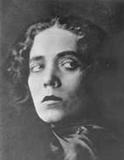
The founder of modern dance in Germany, Mary Wigman began her dance career in Émile Jaques-Dalcroze’s school of rhythmic gymnastics in Hellerau. In 1912 she left Hellerau and became a pupil and collaborator of Rudolf von Laban in Ascona, Munich and Zurich. Wigman’s work as one of the best-known dancers and choreographers of expressive dance contributed greatly to the establishment of dance as an independent art form.
In 1920 she opened her school in Dresden, which she continued to run until 1942. During the war she moved to Leipzig, where she continued to teach under increasingly difficult conditions. In the post-war period, she exerted a great influence on subsequent generations of dancers through her own choreographies as well as by continuing her teaching activities. In addition to manuscripts, letters and documents of her teaching activities, the Tanzarchiv Leipzig also contains many photographs which, in addition to the holdings at the Akademie der Künste, Berlin and the Deutsches Tanzarchiv Köln, are an important source for research into modern dance.
